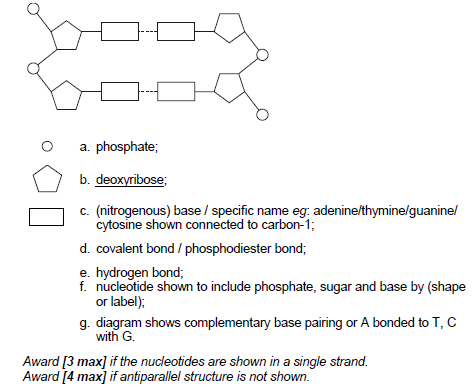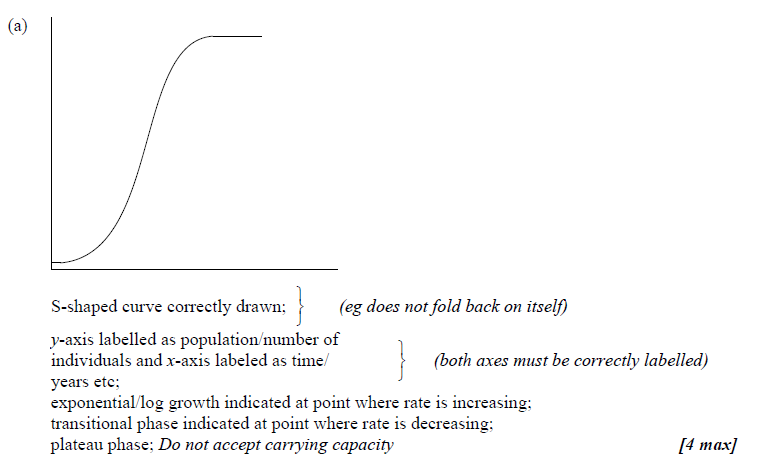Question
Antibiotics such as penicillin are secreted by fungi and other microorganisms in soil. By secreting them, a microorganism can inhibit the growth of a competitor. In research published in 2014, nearly 3000 antibiotic resistance genes were discovered in soil microorganisms, giving resistance to 18 different antibiotics. The types of antibiotic resistance gene varied between soil types.
(a) Explain how natural selection could increase the prevalence of an antibiotic resistance gene in a species of soil bacterium.
(b) (i) There are viruses in soils that are pathogens of animals. Outline a reason for antibiotics in soil not eliminating these viruses.
(ii) Explain the reasons for antibiotics secreted into soil not harming insects or other animals in the soil.
Answer/Explanation
Answer:
(a)
a. if antibiotic is in the environment/soil there is selection (pressure);
b. bacteria without resistance (gene) die / converse;
c. bacteria with resistance (gene) reproduce
OR
bacteria exchange/obtain resistance genes using plasmids/by conjugation;
d. offspring inherit (the gene for) resistance/resistance passed on (to offspring);
(b)
(i)
a. viruses lack metabolism/plasma membranes/cell walls / viruses are not living organisms;
b. antibiotics kill/target bacteria/prokaryotes but not viruses;
c. viral pathogens of animals use animal metabolism (which is not affected by antibiotics);
(ii)
a. antibiotics (only) affect/kill/block processes in bacteria/prokaryotes / do not affect eukaryotes;
b. metabolism/protein synthesis/ribosomes/cell walls not targeted in insects/animals/eukaryotes;
c. no cell walls in animals (so antibiotics cannot attack cell walls);
d. antibiotics are secreted (by microbes/fungi) to prevent competition (with other microbes);
Question
Draw a labelled diagram of a prokaryotic cell.
Bacteria are prokaryotes that sometimes act as pathogens. Describe how the body can defend itself against pathogens.
Explain the evolution of antibiotic resistance in bacteria.
▶️Answer/Explanation
Markscheme
a. cell wall – uniformly thick and drawn outside the plasma membrane;
b. plasma membrane – a continuous single line;
c. cytoplasm/cytosol;
d. nucleoid/(naked) DNA – shown as a tangle of thread or irregular shape without a nuclear membrane;
e. (70S) ribosomes – drawn as a small circle or dark dot;
f. pili – hair like structures / flagellum – shown to be longer than any pili;
g. plasmid – circular ring of DNA;
h. capsule – drawn outside the cell wall;
Award [1] for each structure clearly drawn and labelled which conforms to the italicized guidelines given above.
Remember, up to TWO “quality of construction” marks per essay.
a. skin/mucus membranes act as barrier (to pathogens);
b. sebaceous glands secrete lactic acid/fatty acids/sebum / make surface of skin acidic;
c. (skin/stomach) acid prevents growth of many pathogens;
d. lysozyme in mucus can kill bacteria;
e. pathogens caught in sticky mucus and removed from body;
f. inflammatory response/inflammation can cause swelling/redness/fever (to inhibit the pathogen);
g. phagocytes/macrophages/leucocytes/white blood cells (non-specifically) identify (pathogens/bacteria/fungi/viruses) as foreign;
h. (phagocytes macrophages/leucocytes/white blood cells) ingest pathogens;
i. specific lymphocytes recognize one specific antigen;
j. (antigen-specific) lymphocytes clone themselves;
k. lymphocytes/leucocytes produce antibodies;
l. antigen-antibody complex formed and stimulates destruction of pathogen;
a. antibiotics (are chemicals) used to treat bacterial diseases;
b. within populations, bacteria vary in their (genetic) resistance to antibiotics/fitness;
c. resistance arises by (random) gene mutation;
d. when antibiotics are used antibiotic-sensitive bacteria are killed;
e. (natural) selection favours those with resistance;
f. resistant bacteria survive, reproduce and spread the gene / increase allele frequency of resistant bacteria;
g. the more an antibiotic is used, the more bacterial resistance/the larger the population of antibiotic-resistant bacteria;
h. genes can be transferred to other bacteria by plasmids;
i. doctors/vets use different antibiotics but resistance develops to these as well;
j. multiple-antibiotic resistant bacteria evolve/it becomes difficult to treat some infections;
(Plus up to [2] for quality)
Question
Draw a labelled diagram of a section of DNA showing four nucleotides.
Outline a technique used for gene transfer.
Explain how evolution may happen in response to an environmental change.
▶️Answer/Explanation
Markscheme
Award [1] for each labelled item shown correctly connected.

a. plasmid used for gene transfer/removed from bacteria;
b. plasmid is a small/extra circle of DNA;
c. restriction enzymes/endonucleases cut/cleave DNA (of plasmid);
d. each restriction enzyme cuts at specific base sequence/creates sticky ends;
e. same (restriction) enzyme used to cut DNA with (desired) gene;
f. DNA/gene can be added to the open plasmid/sticky ends join gene and plasmid;
g. (DNA) ligase used to splice/join together/seal nicks;
h. recombinant DNA/plasmids inserted into host cell/bacterium/yeast;
a. (genetic) variation in population;
b. (variation is) due to mutation / sexual reproduction;
c. valid example of variation in a specific population;
d. more offspring are produced than can survive / populations over-populate;
e. competition / struggle for resources/survival;
f. example of competition/struggle for resources;
g. survival of fittest/best adapted (to the changed environment)/those with beneficial adaptations / converse;
h. example of changed environment and adaptation to it;
i. favourable genes/alleles passed on / best adapted reproduce (more) / converse;
j. example of reproduction of individuals better adapted to changed environment;
k. alleles for adaptations to the changed environment increase in the population;
l. example of genes/alleles for adaptations increasing in a population;
m. evolution by natural selection;
n. evolution is (cumulative) change in population/species over time / change in allele frequency;
Suitable examples are antibiotic resistance and the peppered moth but any genuine evidence-based example of adaptation to environmental change can be credited.
Question
List two factors that could cause an increase in the size of an animal population.
1. …………………………………………………………
2. …………………………………………………………
Outline how overpopulation of a species in a given environment may lead to evolution.
▶️Answer/Explanation
Markscheme
a. natality / increased birth rate;
b. immigration;
c. extra food/water / breeding sites;
d. expanding habitat;
e. lack of predators/disease/parasites / reduced death rate;
a. more are born than can survive;
b. there is variety/variability in the offspring;
c. competition for resources / struggle for survival / selection pressure;
d. only the most able/adapted survive / survival of the fittest;
e. the survivors reproduce and pass on genes;
f. genes of less able/adapted are eliminated / change in the gene pool;
g. natural selection occurs;
Question
Reproduction can cause populations to increase rapidly. Draw a labelled graph showing a sigmoid population growth curve.
Explain the various possible consequences of overproduction of offspring.
Outline the role of hormones in the menstrual cycle.
▶️Answer/Explanation
Markscheme

overpopulation/overproducing (of offspring) leads to competition for limited resources/struggle for survival;
example of limited resource; (eg water/space/food)
not all can survive / less adapted will die/migrate;
some varieties/individuals more suited for environmental conditions;
they are more likely to survive and reproduce;
this is natural selection;
increase chances/spread of disease in population;
waste products of the population may reach toxic levels;
may exceed carrying capacity leading to population crash;
Do not accept references between species.
FSH (released from pituitary) stimulates follicle growth (in ovary);
oocytes/egg cells mature;
cells of growing follicle produce estrogen;
estrogen signals endometrium/lining of uterus to thicken;
causes final maturation of follicle;
high levels of estrogen stimulate secretion of LH;
LH spike stimulates ovulation/follicle ruptures releasing oocyte/ova/egg cells;
LH stimulates follicle (left behind in ovary) to develop into corpus luteum;
LH stimulates corpus luteum to secrete progesterone/estrogen;
progesterone/estrogen stimulates continued development/maintenance of lining of uterus (in preparation for implantation of embryo);
if no pregnancy then corpus luteum disintegrates;
drop in progesterone/estrogen hormone levels causes breakdown in uterine lining/menstruation;
progesterone/estrogen inhibit FSH/LH release;
(Plus up to [2] for quality)
Question
Outline two possible consequences of global warming for organisms living in arctic ecosystems.
The changes that result from global warming may lead to evolution. Define evolution.
Explain how sexual reproduction promotes variation in a species.
▶️Answer/Explanation
Markscheme
reduced space/habitat (for ice-dwelling species) / valid example;
increased competition (from temperate species);
arctic species forced to migrate (in search of suitable habitats/food);
changes in patterns of (seasonal) migration;
extinction of some species due to inability to adapt quickly/compete successfully;
increased activity of decomposers;
increased success of pest species including pathogens;
changes in the distribution of prey species;
(cumulative) change in heritable/genetic characteristics of a population;
new species arise from pre-existing species;
change/adaptation of a population due to natural selection / descent with modification;
sexual reproduction involves interbreeding/genetic material from two parents;
new combinations of paternal and maternal chromosomes/alleles/genes / (random) fertilization;
which leads to new genetic combinations/greater variation;
meiosis creates a great variety of gametes;
by crossing-over / by random orientation of alleles (during meiosis);
Question
The following cladogram shows three possible evolutionary routes for the turtle (Turtles 1, Turtles 2 and Turtles 3). The taxa in italics are extinct.
State the organism most closely related to the lizards.
Based on the taxa shown, deduce a difficulty in gathering data to study turtle ancestry.
Molecular evidence is often used to construct a cladogram. Describe one type of molecular-based evidence to identify members of a clade.
Suggest one type of additional evidence that could provide strong support for Turtles 3 as the evolutionary route for turtles rather than Turtles 1 or Turtles 2.
Taxonomists aim to place species into genera, families and higher taxa according to their evolutionary origins. This is known as natural classification.
Explain the usefulness of natural classification in biodiversity research.
▶️Answer/Explanation
Markscheme
Tuatara
some «taxa» are extinct
OR
convergence «of body form» could have occurred (confusing interpretation of the data)
a. base sequences of a gene/DNA/mtDNA
OR
amino acid sequences of a protein
b. species with the most similarities «in base sequence/amino acid sequence/genomes» have recently diverged/a common ancestor/are closely related
OR
members of a clade accumulate the fewest mutations on same base sequences/ vice versa / OWTTE
fossils / comparative anatomy / homologous structures / vestigial structures
a. «because» it allows easier identification of a species
b. «because» it can help identify common ancestors/evolutionary paths/close relationships (showing degree of biodiversity) / OWTTE
c. «because» it is universal/cross-cultural language that avoids problems of local names of organisms
OR
«because» it promotes international collaboration
OR
«because» it facilitates access to the history/background of the species /indexing for retrieval of relevant «taxonomic» information / OWTTE
d. «because» it allows «biodiversity» research of larger taxa «ie examination of a family of large cats rather than one species»
